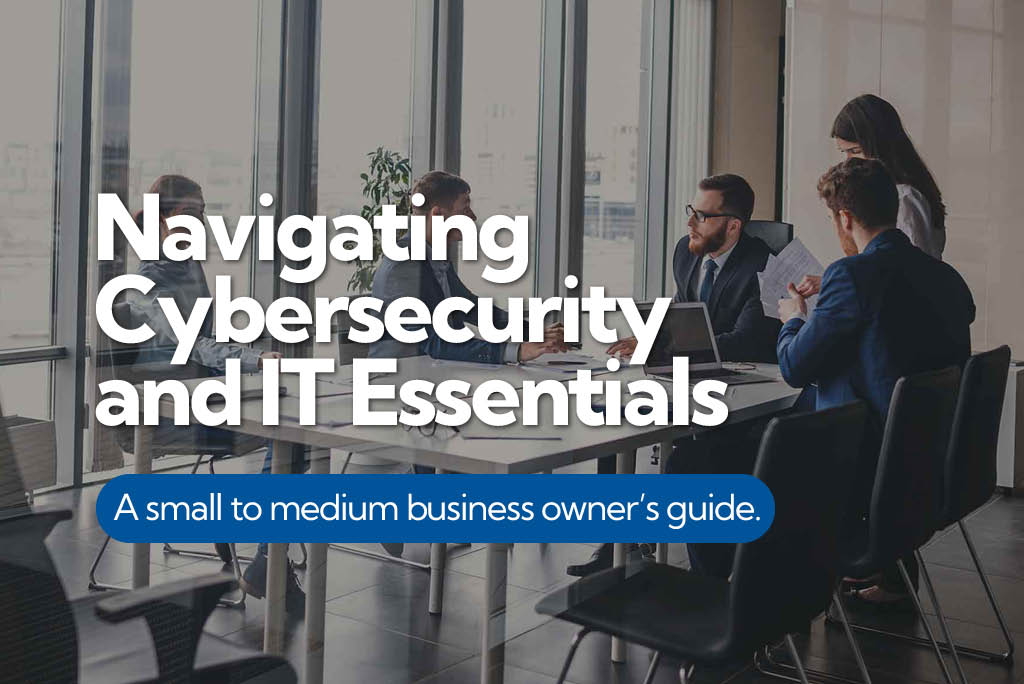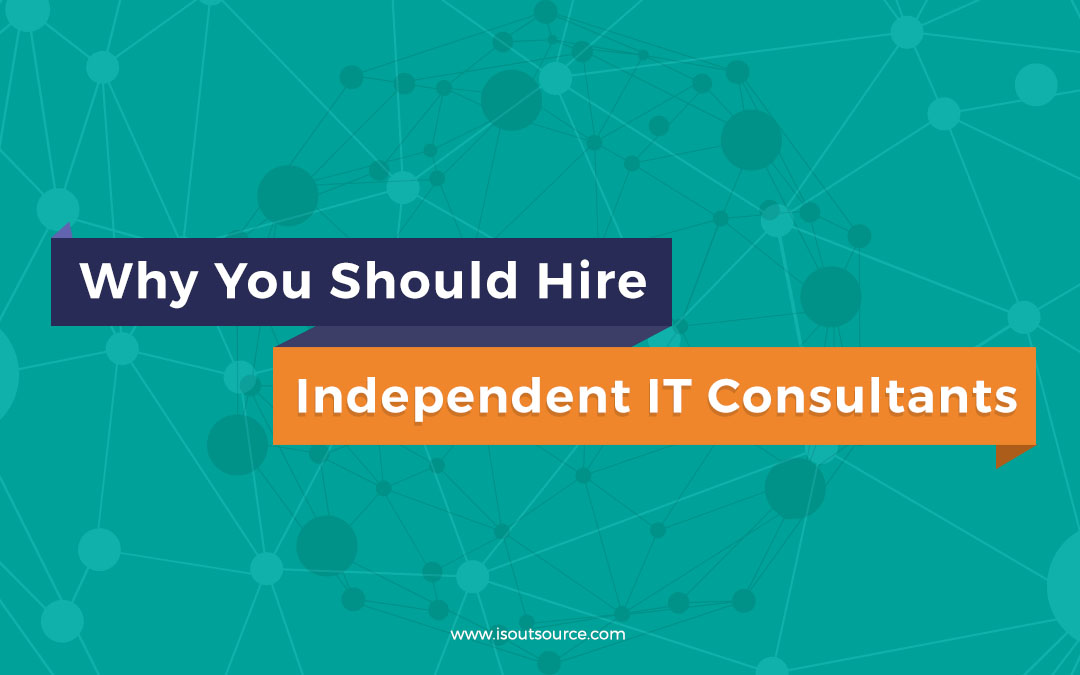IT Outsourcing
Comprehensive Guide to IT Outsourcing
Outsourcing IT may also be one of the best decisions your business ever makes—one that allows it to adapt, grow, and thrive in an economy increasingly driven by technology.
Relying on a services provider to assist with some, most, or all aspects of IT has become a common, even standard, business strategy in the United States and around the world. Predictions suggest that trend will continue, with more businesses choosing to outsource and current customers seeking more services than before. IT services became the single largest source of IT spending for the first time in 2024 according to Gartner.
Companies clearly see benefits from IT outsourcing. However, deciding to outsource something as sensitive and strategic as IT to a third-party has serious consequences, and the outcome can be positive or negative depending on decisions made along the way.

Benefits of Outsourcing
IT for Small Business
This Master Guide explains everything you need to know about IT outsourcing, helping you determine why, when, and how to leverage tech partners to maximize your revenue, resilience, and relevance.
In This Guide
- How IT Outsourcing Can Benefit Your Business
- When to Outsource Your IT
- How to Outsource Your IT
- How to Find the Right IT Outsourcing Partner?
- Outsourcing IT vs. In-house: Pros and Cons
- What are the Most Commonly Outsourced IT Services?
- Risks of IT Outsourcing
- Can IT Cybersecurity Be Outsourced?
- Choosing IT Outsourcing
- Contact Us Today
- Case Studies
- More Resources
How IT Outsourcing can Benefit Your Business
Technology provides public organizations, private companies, and nonprofit entities with tremendous opportunities to increase efficiency, productivity, revenue, innovation, and so much more. Digital tools make it possible to solve your oldest and largest problems while operating with speed, scale, and skills that would have been impossible in the past. And for small businesses in particular, technology helps lean teams accomplish incredible things and compete against larger players. But all these advantages come at a cost.
Today’s technology requires significant financial investments, both upfront and over time, that can increase rapidly and unexpectedly over time. Implementing and managing an IT infrastructure takes a dedicated team of technical professionals with diverse skills, and even with the right people in place, making complex webs of technology work as intended takes tremendous amounts of time and effort. Companies want and need to utilize technology to the fullest—yet doing so take ever-increasing amounts of time, money, and specialized skills, often in excess of what companies are willing or able to expend.
IT outsourcing shifts the burden of managing technology or software development from the in-house team to a trusted third-party. And, by doing so, it increases the benefits of that technology, allowing companies to reap bigger and better results using less time and money. Every company, even small ones, now needs a digital footprint to remain relevant and competitive. For many, IT outsourcing is the fastest, easiest, most affordable, and most secure way to get there. No wonder spending on IT services has been growing for years.
Specific benefits of relying on managed IT services include:
- Manage IT Costs – Tech partners offer access to software, hardware, and talent for a cost that’s usually less than buying the same tools and hiring the same staff, that’s also more visible and predictable than budgeting for internal IT spending.
- Accelerate Digital Transformation – Becoming a digitally mature organization with interconnected systems and data sources is much easier with tech experts to create and orchestrate a plan that connects your current tech to your longer-term business objectives.
- Scale Larger and Faster – IT outsourcing allows you to scale your IT infrastructure up or down, to whatever level is required, simply by notifying your service partner, so you can easily adapt to changing business circumstances or market forces.
- Be More Competitive – Smaller companies can have the same tech capabilities as bigger companies, plus greater insights, agility, and innovation than their closest competitors, when they have an outsourced IT partner to turn their digital strengths into a key differentiator.
- Solve IT Issues – Providing tech support and managing IT issues with the help of a tech partner ensures that employees have the support they need, when they need it, and your company always has the resources to quickly and effectively troubleshoot tech problems.
- Leverage Top Talent – As technology and cybersecurity talent becomes harder to recruit and more expensive to retain, IT outsourcing ensures your in-house team has the people, skills, and 24/7/365 coverage it needs without the cost of hiring a world-class team internally.
- Maximize Uptime – Managed IT services provide the benefits of a help desk to companies without one so that employees have reliable access to critical apps and data and downtimes don’t cause disruptions or interrupt business continuity.
- Fight Cyber Attacks – Companies are at lower risk of cyber attacks with a service provider to assess, improve, and manage their cybersecurity, detect and respond to attacks round the clock, and fill any gaps in their security team or strategy.
When to Outsource Your IT
It bears repeating that IT outsourcing isn’t a universal strategy. It’s not automatically the right choice for all companies or all technology, and new businesses shouldn’t consider this the only option. After all, plenty of businesses want, need, and have their own in-house IT teams. Rather than considering IT outsourcing to be a foregone conclusion, confirm that it’s the best move for your IT infrastructure, business strategy, and market conditions.
Some companies outsource IT because their technology budget is ballooning or their apps and services suffer from frequent downtime, performance problems, or security issues. Other companies lean on a managed IT services provider to expand and improve their digital capabilities, making new technologies accessible and affordable. Help with compliance and keeping pace with growth are other issues that drive companies to outsource IT, or they may be seeking vCIO or vCISO services as an alternative to recruiting these executives.
In most cases, it comes down to a simple formula: If the technology your company requires exceeds what it can accomplish on its own given the time, money, and skills available, outsourcing makes up the difference.
See How ISOutsource’s Managed IT Services
Can Help Your Business
How to Outsource Your IT
IT outsourcing doesn’t follow a one-size-fits-all formula since companies seek outsourcing partners at different stages of growth, for different services and technologies, and to greater or lesser extents. Every outsourcing relationship looks a little different, and should, making it important to create alignment between you and the provider. Follow these best practices to understand where and how outsourcing might be beneficial, then use those requirements to help vet possible service providers:
- Unite Stakeholders – Gather stakeholders from inside and outside IT to discuss the current state of technology and forecast future needs.
- Define Weaknesses – Identify any problems, weaknesses, or pain points with the current technology.
- Review Strategy – Compare how the current technology affects the long-term business strategy.
- Find Opportunities – Assess where IT outsourcing would be most advantageous or most essential.
- Quantify Goals – Set goals for what outsourcing will accomplish, including timelines and benchmarks.
- Prioritize Requirements – Detail and prioritize what skills and services an outsourcing partner must provide.
- Review Plans – Verify that all stakeholders agree on all aspects of the outsourcing plan.

Navigating Cybersecurity & Technology
Enhance Business Operations, Minimize Risk,
and Optimize your Technology Strategy
How to Find the Right IT Outsourcing Partner?
Whether or not IT outsourcing facilitates the goals outlined in the previous section depends on which partner you choose. The IT services market is crowded, competitive, and complicated, making it difficult to compare options and raising the odds of choosing the wrong one. Most companies in the United States will need to choose from multiple potential partners, often with similar service offerings.
You can’t rush to make a choice. That said, waiting only delays the benefits longer, and time may be sensitive. A process based on proper due diligence will work systematically through these steps:
-
- Do Your Research – Find all the providers that serve your area and offer the tech you want. Ask business contacts for recommendations, and consider unexpected providers like consulting firms or SaaS solutions.
- Stick to the Plan – You already have a plan for what your IT partner needs to provide. Do not waiver from that plan or decide to accept less, more, or something different than what you intended. Vet any provider based on their ability to provide exactly what you want.
- Consult References & Reviews – Get objective opinions about a provider by reading reviews, checking ratings, and consulting references. Good providers will be able and eager to provide you with references and third-party assessments.
- Sweat the Details – Pay very close attention to the details of the cost structure, service level agreement, and any terms and conditions that apply. These details determine, for better or for worse, how services are actually delivered and who is accountable for what.
- Consider Compliance and Cybersecurity – Anyone handling your IT and data may put your cybersecurity strategy at risk or make you non-compliant with regulations inside and outside the United States. Verify that any candidate has the security, certifications, and compliance expertise your business requires.
Outsourcing IT vs. In-House: Pros and Cons
Some businesses outsource all their IT, relying on a service provider for all their tech needs and eliminating the need for an in-house IT team. Other businesses outsource none, preferring to manage tech entirely in-house. Perhaps most common is a hybrid model, where companies supplement their own tech tools and teams with services, systems, and/or support from a third-party.
As we have stressed throughout, every business must determine for itself what their IT outsourcing strategy looks like. To that end, consider the primary pros and cons of outsourcing vs. in-house IT:
Outsourcing IT
- Pros- You get the advantages of having resilient and powerful technology without the cost and complexity of managing that technology in-house.
- Cons – You trust something as business-critical as IT to a service provider who may not be as skilled, dependable, or cost effective as they claim to be.
In-House IT
- Pros – You have complete control over your technology, including how it gets implemented, optimized, and secured, without having to make compromises for a third-party.
- Cons – You have full responsibility for managing technology, requiring significant amounts of time, money, and troubleshooting that may not be adequate to make tech an asset.

IT Provider vs In-House Tech Support:
The Cost-Saving Solution
What Are The Most Commonly Outsourced IT Services?
The most sensitive, difficult, or essential elements of IT are the ones that businesses tend to outsource—but a quality managed services provider will be equipped to offer a huge range of services and support functions, tailored into a package to meet your specific needs. These are the most common services, though many others are available:
- Managed IT Services – Key parts of your IT infrastructure are managed and monitored by a third-party
- Email & Server Migrations – Help with moving critical assets safely and seamlessly
- IT Support – Someone to call on when tech issues arise, for anything at anytime.
- Managed Cloud Services – Keep private, hybrid, or multi-cloud environments optimized.
- Backup and Recovery – Ensures that data is backed up and easily retrievable if necessary.
- Mobile Device Management – Make sure mobile devices are secure and productive.
- Managed Cybersecurity – Rely on security experts to prevent, detect, and respond to threats.
- IT Consulting – Get in-depth advice and technical planning to meet tech and business goals.
- Assessment & Audits – Determine if current tech meets security, compliance, or strategic goals.
Risks of IT Outsourcing
As with any significant business decision, it’s important to consider the possible risks of outsourcing IT. Many businesses become better thanks to their tech partners, but there are exceptions. Knowing where outsourcing might go wrong makes it easier to ensure it goes right.
Giving a third-party control of technology means they could mismanage that technology in ways that negatively affect your company. That could take many forms, but all these risks have the same source: working with the wrong provider of IT outsourcing services.
Fortunately, you can easily avoid this situation through careful vetting and due diligence. Follow the guidance outlined earlier, with a particular emphasis on two steps. First, check references to see what the customer experience really looks and feels like. Second, create close alignment between what your company needs and what the service provider offers.
Most providers will appear to be at least adequate, but very few will be the right tech steward for your business both now and years from now. While it may appear urgent or advantageous to pick a partner sooner rather than later, the single best way to avoid the risk of IT outsourcing is by spending more time evaluating vendors.
Can IT Cybersecurity Be Outsourced?
Cybersecurity can be outsourced to managed IT services providers who will monitor for threats, handle incident response and disaster recovery, and put other essential responsibilities into the hands of seasoned security professionals. They also offer access to quality cybersecurity tools and 24/7/365 coverage. Some providers offer limited or specialized cybersecurity services while others handle everything you need to stay secure and compliant. As cybersecurity becomes a bigger risk and a bigger burden, requiring teams, tools, and time to stay on top of, many companies are concluding that outsourcing is the best, or in many cases only, way to keep their company ahead of attackers.

7 Core Elements
for your Cybersecurity Strategy
Safeguard your business against attacks
Conclusion – Choosing IT outsourcing
IT outsourcing helps businesses reduce the cost, complexity, and burden of technology. At the same time, it gives them the benefits of powerful, secure, and scalable tools aligned with their strategic objectives.
Outsourcing IT makes sense for most companies, and especially for companies without extensive in-house tech expertise, but it’s not a decision to make lightly, and the choice of provider couldn’t be more important. Always consider multiple options.
To get the most from outsourcing IT, follow this final piece of advice: explore everything a service provider can offer, because it might be more extensive, valuable, or relevant than expected. Tech partners are some of your closest business allies. Take full advantage of all the tools, skills, and strengths they can offer.
Empower your Business With Smart IT Solutions
Contact Us Today to Discuss Your Specific IT Needs
Case Studies

Bodypoint’s Success Story
Read the Case Study

Integrated Rehabilitation Group
Read the Case Study

EvolvedMD
Read the Case Study
More Resources

Blog
Why You Should Hire Independent IT Consultants
(IT) is essential for a functioning business in the modern era. But it can also be overwhelming and confusing for those who haven’t…

Blog
IT Provider vs In-House Tech Support: The Cost Saving Solution
Hiring your tech support can be a drag. Forget, for a moment, about all the wide-ranging resumes flooding your inbox and the whiteboard…

Blog
4 Benefits of IT Help Desk Services
No one likes experiencing IT problems, us included. This is why we have a dedicated IT help desk to quickly troubleshoot and resolve…

Blog
6 Ways to Empower Your IT Team for Success
When you empower your IT team for success, you give your business more power to succeed as well. Support your IT team, help them reach…

Blog
The value of vCIO Consulting
The role of a Chief Information Officer (CIO) is becoming increasingly essential to business operations. But finding a good one that fits…

Blog
Why Every Business Needs a Virtual CISO
In the old days, business owners worried about protecting only their physical assets. Now, protecting digital assets is just as…
